

Students as evaluators in inquiry-based classrooms. In a previous post entitled Who do our students consider the audience?

, I advocated that by providing rich, complex, authentic classroom tasks, we open the door to expanding the role of students. They move from producers to evaluators of their classmates' solutions. I shared that we need more environments like this because they enable students to be engaged in creating content, and the resulting products are far more meaningful in fostering learning that will stick. I would like to add a Part 2: These environments are far more powerful and effective in fostering reflection and growth about each child’s learning process. To be clear, students can and should be reflective learners in any environment. Students as evaluators Traditional environments ask students to turn in work to the teacher for evaluation; students are seldom placed in the role of evaluating quality of their own work, let alone another classmate.
Guided Inquiry graphic. Forums - Forums. EJ1045936. CISSL - CISSL. Challenge and Change. Home of History Education: National History Day. Building Guided Inquiry Teams for 21st-Century Learners. School Library Monthly/Volume XXVI, Number 5/January 2010 Building Guided Inquiry Teams for 21st-Century Learners by Carol C.
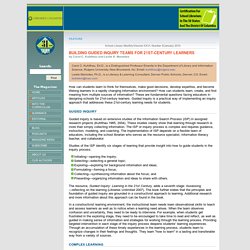
Kuhlthau and Leslie K. Maniotes Carol C. Austcurr_gi_web20_unit-template-master.pdf. Teach Students to Ask Their Own Questions. This process explicitly validates all students’ intellectual abilities.– High School History Teacher, New York The reasons behind their questions often bowl me over with their sincerity, the fact that [they] really want to know the answers because it’s important to them, or they feel it would be important for others to know.– 4th Grade Teacher, Chicago The ability to produce questions, improve questions and prioritize questions may be one of the most important—yet too often overlooked—skills that a student can acquire in their formal education.
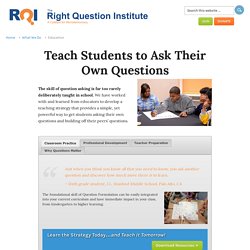
Strong critical thinking is often grounded in the questions we ask. By deliberately teaching questioning skills, we will be facilitating a process that will help students develop a mental muscle necessary for deeper learning, creativity and innovation, analysis, and problem solving. Join the Movement: Make Question Formulation a part of Every Child’s EducationGet Involved » Are We Asking the Right Questions. Amazon. Inquiry Charts (I-Charts) Classroom Strategies Background The Inquiry Chart (I-Chart) is a strategy that enables students to generate meaningful questions about a topic and organize their writing.
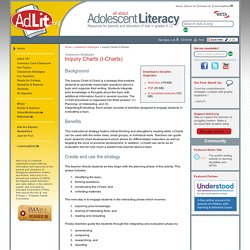
Students integrate prior knowledge or thoughts about the topic with additional information found in several sources. The I-Chart procedure is organized into three phases: (1) Planning, (2) Interacting, and (3) Integrating/Evaluating. Each phase consists of activities designed to engage students in evaluating a topic. Benefits This instructional strategy fosters critical thinking and strengthens reading skills. Create and use the strategy The teacher directs students as they begin with the planning phase of this activity. Inquiry Chart. Gr 5-8 Research Guide: Introduction and Skills Menu. About the Guided Inquiry research process: There are many different ways to approach research, but research is often easiest if you use a model with specific steps that can be applied to any topic you might choose.
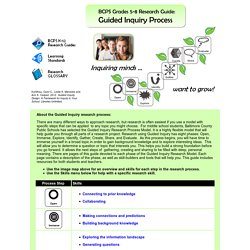
For middle school students, Baltimore County Public Schools has selected the Guided Inquiry Research Process Model. It is a highly flexible model that will help guide you through all parts of a research project. Research using Guided Inquiry has eight phases: Open, Immerse, Explore, Identify, Gather, Create, Share, and Evaluate. As this process begins, you will have time to immerse yourself in a broad topic in order to gain background knowledge and to explore interesting ideas.
Use the image map above for an overview and skills for each step in the research process. BCPS Grade 6 Reading Research Portal. Copyright 2014, Baltimore County Public Schools, all rights reserved.
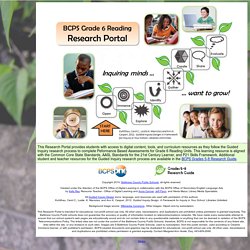
Created under the direction of the BCPS Office of Digital Learning in collaboration with the BCPS Office of Secondary English Language Arts by Kelly Ray, Resource Teacher - Office of Digital Learning and Anna Conner, Jeff Flynn, and Alexis Mazur, Library Media Specialists. All Guided Inquiry Design icons, language, and resources are used with permission of the authors: Kuhlthau, Carol C., Leslie .K. Maniotes, and Ann K. Caspari. 2012. Inquiry-Based Lesson Plans. Inquiry Learning Student understanding is the central focus of inquiry learning.

Students actively participate in inquiry learning experiences by developing questions and investigating to find solutions. Teachers facilitate learning as students engage in active problem solving, the construction of meaning and the communication of new understandings to students, teachers or other important adults. Just Science Now. Guided Inquiry The following standards-based lesson plans—from the Beacon Learning Center—provide practical classroom applications of guided inquiry.
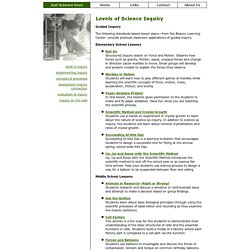
Elementary School Lessons Roll On Structured Inquiry lesson on Force and Motion. Observe how forces such as gravity, friction, equal, unequal forces and change in direction cause marbles to move. Small groups will develop and present models to explain the forces they observe. Problem loading page. Guided Inquiry: An Instructional Framework for Designing Effective I… Mhsviewersguide.pdf. Beginning Your Inquiry 7th - 10th Grade Worksheet.
GUIDED INQUIRY by AASL STANDARDS - Google Sheets. Home - LibGuides Index at North East ISD. Rapid Changes in Earth's Surface- A Model Third Grade Guided Inquiry Unit -